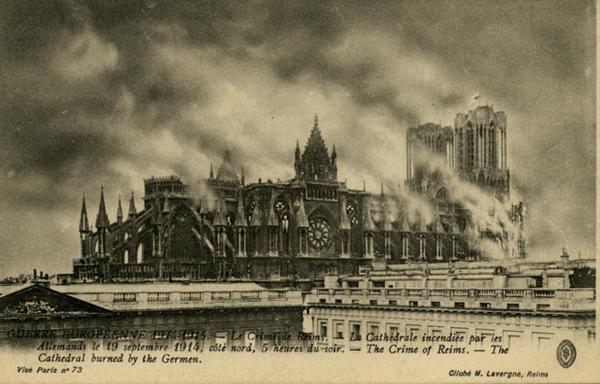On 20 September 1914, German shellfire burned, damaged and destroyed important parts of the magnificent Cathedral of Reims. The destruction of the Cathedral was generally regarded as an act of sheer vandalism. At the time, it was generally admitted by writers on international law that if the military commander of a besieged place used a church or other building whose immunity had been established, as a stronghold, a storehouse, or an observatory, the besieger might bombard the site without being held responsible for damages caused in consequence of their proximity to other buildings which are liable to bombardment. Even the French war manual itself admitted this.
On 20 September 1914, German shellfire burned, damaged and destroyed important parts of the magnificent Cathedral of Reims, seat of the Archdiocese of Reims, where once the Kings of France were anointed and crowned. Scaffolding around the north tower caught fire, spreading the blaze to all parts of the carpentry superstructure. The lead of the roofs melted and poured through the stone gargoyles, destroying in turn the Bishop's Palace. The Cathedral was falling stone by stone and there was little left except the west front and the pillars. Images of the Cathedral in ruins were used during the war as propaganda images by the French against the Germans and their deliberate destruction of buildings rich in national and cultural heritage. Restoration work began in 1919, under the direction of Henri Deneux, a native of Reims and chief architect of the Monuments Historiques; the Cathedral was fully reopened in 1938, thanks in part to financial support from the Rockefellers, but work has been steadily going on since.
The destruction of the Cathedral was generally regarded as an act of sheer vandalism. The pretext alleged by the Germans as a justification for the bombardment was that the towers of the Cathedral were used by the French for purposes of military observation. The French were also reproached for making no effort to extinguish the flames, and the local authorities were accused of omitting "with almost incomprehensible negligence" to take measures to insure the safety of the art treasures, although they had ample opportunity to do so after the evacuation of the town by the German troops. The French authorities entered into emphatic denial. Not only were the towers never used by the French as posts of observation, in fact a Red Cross flag had flown from the building in which German wounded had been collected and were being cared for; and this was the testimony of the population of Reims (see for example General Joffre's statement in Revue Gén. de Droit Int. Pub. (1915), p. 83).
International law
At the time, it was generally admitted by writers on international law that if the military commander of a besieged place used a church or other building whose immunity had been established, as a stronghold, a storehouse, or an observatory, as the French were alleged to have done at Metz, Strasbourg, and Toul during the Franco-Prussian War of 1870/71, the besieger might bombard the site without being held responsible for damages caused in consequence of their proximity to other buildings which are liable to bombardment. Even the French war manual itself admitted this.
Whether or not the German allegations were true in 1914, another question arose in the two following years. What justification was there for the Germans for continuing the bombardment at irregular intervals in 1915 and 1916, when according to their own admissions, the Cathedral was no longer being used for purposes of military observation? Nothing but considerations of the gravest military necessity could have justified the destruction of a monument which not only was regarded as one of the architectural glories of France, but which in a sense belonged to all mankind. As Garner stated in his International Law and the World War, p. 445 'Monuments of this stature are not only entitled to respect because of their sanctity but are especially protected by the Law of Nations'.
- Garner, J.W., "§ 285. The Destruction of the Cathedral of Reims." and "§ 286. The German Defence Analyzed.", in International Law and the World War, London, Longmans, Green and Co., 1920, pp. 440-446.
- Kriegsministerium (Hrsg.), Die Beschießung der Kathedrale von Reims, Berlin, Georg Reimer, 1915.
- Landrieux, M, The Cathedral of Reims: the Story of a German Crime, London, Kegen Paul, Trench, Trubner & Co., 1920. [French ed.: La cathédrale de Reims: un crime Allemand, Paris, Renouard, H. Laurens, 1919.]
- Louvain and Reims Cathedral before and after their Destruction by the Germans, London, 1915.
- Société des Amis de la Cathédrale de Reims, Pour qui n'a pas vu Reims au sortir de l'étreinte allemande (octobre 1918) la cathédrale, la ville, Paris, 1920.
